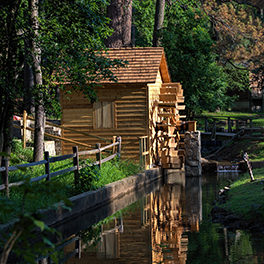The History of Willow Springs
"It takes a village to build a village."
Established in 1991, the park initially featured only a handful of buildings reflecting the era from 1735 to 1785 in the Augusta area. Through the dedicated support of numerous volunteers and the generous contributions from local businesses in the form of grants and donations, the park has evolved into a renowned destination attracting visitors from across the globe. It’s important to note that securing grants necessitates the raising of matching funds to access the grant money. Your assistance with both current and future projects is invaluable. Whether through donations or volunteering, your support is crucial. Over the past 30+ years, the park has flourished into a cherished community “jewel,” owing much of its success to the active involvement of the community.
If the title of the building is “underlined”, please click on the title to reveal detailed pictures for that project.

Olde Towne Preservation Association

A Park was born!
The members of the OTPA had found land that was an old abandoned water works for North Augusta. In February of 1993, the city officially gave the OTPA permission to transform the open area into the Living History park.

Blacksmith's Forge
The original forge was put up in 1993. It consisted of four power poles and a flat roof. In 2007, they built the chimney and closed in the sides. In 2020, they fixed the pitch of the roof and raised the chimney.

Potter's Shed (formerly Slave Quarters)
The original structure was built in 1993 and then modified in 2004. The wood used was scavenged from houses being torn down in North Augusta. It was redone in 2017 by Brian DeJong to transform it into the Potter's shed with a working kickwheel and display space.

Spring House Tavern
The Tavern was originally provided the water supply for North Augusta. In 1995, the city decided to let the OTPA use it for a tavern.
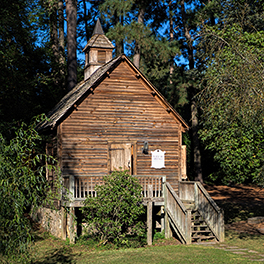
Meeting House
This was the first time the park received a government grant from the SC Heritage Corridor. This was combined with donations to finance the construction.

Perry Hill's Cabin
This typical log cabin was built by Bob Perry, Allan Burk and several other volunteers. Funds were provided by grants received from South Carolina National Heritage Corridor.

Thompson Academy
This building was constructed at the same time as the Perry Hill Cabin by Ted Greer, Jr. The structural design was donated by Wayne Moore, Moore and Assoc. Funds were provided by grants received from South Carolina National Heritage Corridor.

Official Lease Signed
In January of 2005, the OTPA signed a lease with the city of North Augusta that covered the full 7.35 acres that the park covers today. Prior to this, they only had the use of the lower level of the park.
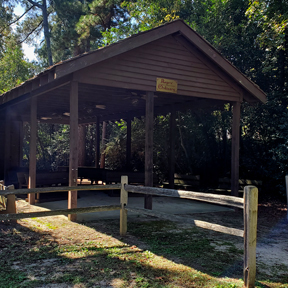
Roger's Ordinary
The public events were becoming more and more popular and we needed a place for people to sit and eat. A tavern in Colonial America was often called the “ordinary”. It’s where colonists would go to get “ordinary” food.

Sensory Garden
The garden was built for the handicapped and blind at the request of the North Augusta Lion's Club. They gave the park a substantial donation that started this project but funds from several grants and donations were needed to finish. This project was a significant undertaking and took over two years to complete. This project was the first to be completed after the city granted the OTPA use all 7.35 acres.

The Livery
The building was on the property when the park began. It was a cinder block building, so we wrapped it with wood siding and raised the roof. It houses a full kitchen that is used for park events, our public bathrooms including showers, and provides much needed storage space. Funds from a South Carolina Heritage Corridor grant were used for this project.

Norwood House
This house and landscaping were donated by Georgia Congressman Charlie Norwood's family. The design was based on one of the most famous tiny houses built by Thomas Jefferson in the late 1700’s called the “Honeymoon cottage”.

Print & Post Shop
This is the only building at the park that wasn't constructed on site. It was donated and moved from Charleston, SC.

Corn Crib
The base of the Corn Crib was the pit used for cooking meats for the public events. The location was repurposed into a Corn Crib which would be typically located near a gristmill to store the corn.

Guard House
We wanted to add a building to the park entrance on Lake Avenue.

Colonial Barn
The upkeep of the park even with grants is expensive so the OTPA looked for ways to generate income to help offset the many expenses. The barn design is a traditional New England Colonial style and was chosen because the "tobacco" barns of the South were not attractive.

New Windsor Cabinet Shop
It only made sense to build a cabinet shop for the park since we had a volunteer that graduated from the Massachusetts Institute of Period Furniture Makers living across the street. This addition provided demonstration space as well as the perfect location to build furniture for the rest of the park.

Village Mercantile
When the Windsor Cabinet Shop was being designed this space was planned to be storage space for wood. The gift shop was in the Print & Post shop at the time and it was too small so they changed plans and built the Mercantile.
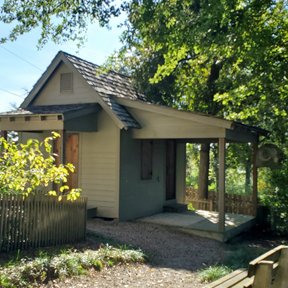
Sign of the Ram
The public events were growing in popularity and more demonstration space was needed. This building is typical size for a colonial demonstration building or shop and completed the village.
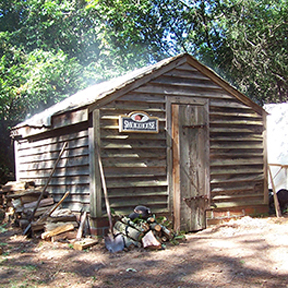
Smokehouse
This is not the original smokehouse at the park. The first one was destroyed by termites. A smokehouse like a spring house was a necessity for cooking and storing meats.
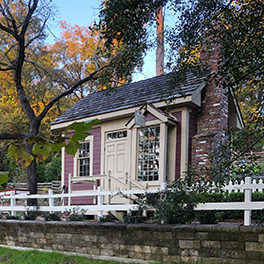
Sweet Shoppe
This building was originally the Apothecary. It was built to complete our Willow Springs village.4

Spring House
Spring House's were a staple in Colonial times for storing food. This was quite the project for such a small house.
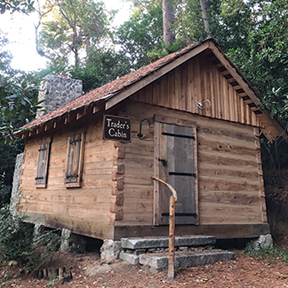
Trader's Cabin
This cabin was intentionally constructed outside of the village to show visitors what life was like for those who didn't live in town. Trader's would build cabins close to the Native American territory to promote trade and they also served as a first line of defense in case there was trouble headed to the village.

Hank McKenney Glass House & Gradens
Hank McKenney, former mayor of North Augusta, was a main supporter of the Park from the beginning. He was a reenactor, master gardener, and an excellent cook. If you didn't find him in the gardens, you were sure to find him in the kitchen. The Glass House is a style you would find in Colonial times.

The "jim" Farmer's Barn
Named after a long-time supporter of the Park, the pole barn is the latest addition to the Living History Park. The Pole Barn will provide much needed outdoor space for living history demonstrations and private events.

